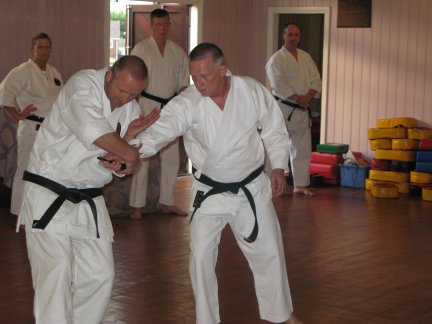Welcome
Garswood Goju Ryu Karate
Garswood Dojo practises traditional Goju Ryu Karate, the roots of which are directly traced to the early foundation of Karate in Okinawa. The club is run by Sensei Tony Bewley a 7th Dan British Karate association with over 40 years of experience in Goju Ryu Karate. Goju Ryu (Japanese for "Hard-soft style") is a style of karate, which uses a combination of hard and soft techniques.
It is commonly believed that the concept of combining the two extremes originated in a Chinese martial arts doctrine known as wu pei chih. Goju-ryu combines hard striking attacks like kicks and punches with softer circular techniques for blocking and controlling the opponent, including locks, grappling, takedowns and throws. Goju-ryu's speciality is in-fighting or close-quarter combat. Major emphasis is given to breathing correctly. Goju-ryu is one of very few karate styles that practice methods of which include body strengthening and conditioning, its basic approach to fighting (distance, stickiness, power generation, etc.) and its partner drills. Goju-ryu has the sophistication of being both linear and circular making it usable by all ages, sizes, and genders.
What's In A Name?
'Go' means hardness or external force, 'ju' means softness or internal force.
|
This line, which appears in a poem, the Hakku Kenpo (roughly, "The eight laws of the fist"), describing the eight precepts of the martial arts, reads, “Ho wa Gojū wa Donto su” (the way of inhaling and exhaling is hardness and softness, or everything in the universe inhales soft and exhales hard).

Higashionnas most prominent student was Chojun Miyagi (1888-1953) who began training under Higashionna at the age of 12.
After Higashionnas death Miyagi sailed to China and studied there for several years, returning to Naha in 1918. Many of Higashionna's students continued to train with him, including Higa Seiko (1898-1966). However, Higashionna's most senior student Juhatsu Kyoda, who studied under Higaonna one month longer than Miyagi, formed his school To'on-Ryu ("Higaonna's style") preserving more of Higashionna's approach to Nahate.
Goju-Ryu was the first officially recognized style of Karate in Japan by Dai Nippon Butokukai and the only style of Karate with a full historical representation in both Okinawa and Japan.